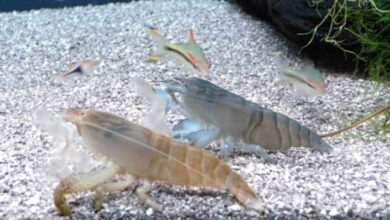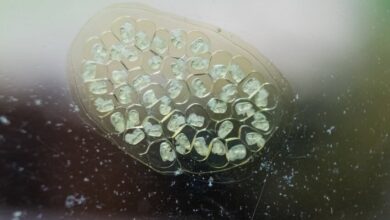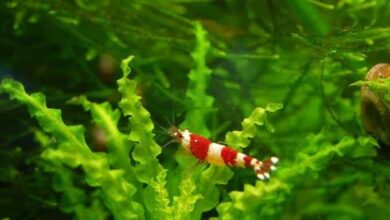Cherry Shrimp – neocaridina heteropoda: Care Guide

Cherry Shrimp are a common and highly recommended addition to freshwater aquariums around the world. They are easy to care for, get along with their tank mates, and are a lot of fun to watch.
Also, they love to nibble on algae in your tank, which is a huge benefit in and of itself.
In this guide, we cover everything you need to know to become a Cherry Shrimp expert. General information, basic care, ideal tank conditions and more.
Species Overview
Cherry shrimp, also known as red cherry shrimp (neocaridina heteropoda is its scientific name), are an active group of freshwater invertebrates found naturally in Taiwan’s streams and ponds.
They are a small freshwater shrimp (or dwarf shrimp) in the atyidae family that is a popular species within the freshwater aquarium community. In an appropriate, easily managed environment, these small algae-eating shrimp are hardy and valuable to the surrounding ecosystem.
With proper care, cherry shrimp will likely live somewhere in the one to two year range. , with high reproductive potential and minimal maintenance.
Cherry shrimp are also “graded” on a color system between breeders and sellers, which will be discussed below.
Appearance and size information
Cherry shrimp are different shades of red and small, growing only up to an inch and a half long. Females tend to be larger and slightly more colorful than males.

However, if the cherry shrimp are experiencing stress in their environment, they will lose their coloration.
It is difficult to differentiate between males and females until the shrimp are sexually mature. Once mature, females can be selected for by the presence of an orange «saddle» area under the tail (used to hold eggs once hatched).
Due to selective breeding, the red colors seen in captive Cherry Shrimp are much more consistent in shade than in the wild, which have a wider range of colors.
Scale of colors
In an effort to measure the quality and value of these shrimp, four color “grade” levels are used to classify each individual. They are the following:
- High Grade: Fire Painted Cherry Red Shrimp – The highest grade, also the most expensive of the bunch. They have a red entire body, including the legs, which is unique to this type of shrimp.
- Medium-high grade: Fire Red Cherry Shrimp – Only reds on their bodies.
- Medium grade: Sakura Cherry Shrimps: Mainly red in color with scattered light colored spaces on their bodies.
- Lowest Grade: Basic Cherry Shrimp – Lowest grade and least expensive. These are mostly clear and have some red areas on their bodies.
The price of these shrimp increases with the grade, as well as the quality of water required. Higher grade Cherry Shrimp need more stable/cleaner water conditions to thrive, while lower grade Shrimp can tolerate poorer water quality without becoming as stressed.
Cherry Shrimp Care
Cherry shrimp care is simple and easy. These animals require very little maintenance and will thrive as long as you take care of their basic needs.
In this section, we will cover the essentials you need to keep in mind when it comes to caring for Cherry Shrimp.
Water base parameters
Cherry Shrimp are flexible when living in tank conditions. Their main need is for water levels to remain stable. Any fluctuation in water quality can cause stress to them that can shorten their lifespan.
- Water temperature – A heater is not necessarily needed for shrimp water. It simply needs to be between 65 and 85 degrees Fahrenheit, often at room temperature. If the water is kept at the higher end of this range, it can speed up the reproduction and growth rates of the Cherry Shrimp.
- pH levels – The pH in the tank should be between 6.5 and 8. Peat moss can be added to the water to naturally lower the pH level if needed.
water cleaning
As mentioned above, with higher quality shrimp there needs to be a higher quality of water to accommodate them. If the tank has lower quality Cherry Shrimp, this is not as much of a concern.
Another very important thing to remember is that cherry shrimp are sensitive to levels of chlorine, ammonia, nitrite, and nitrate.
There must be zero nitrite in the water before you put the shrimp in the tank. Nitrates must be less than 20 ppm (parts per million).
Adding a dechlorinator to the tank water a few days prior to shrimp placement will ensure the chlorine level does not get too high. These levels tend to be easier to maintain in larger tanks with more water.
Filtration Guidelines and Bioburden
One of the coolest things about Cherry Shrimp is that they have a low bioburden, which means they don’t produce a lot of waste. This helps maintain better water quality and makes it easier for beginning tank owners to regulate conditions. Always make sure to cycle the tank before adding animals as well.
When using filtration systems, precautions must be taken. Because cherry shrimp are a dwarf species, they can easily be sucked into the filtration system if it is too powerful.
To prevent this, a sponge filter can be used. Blocking the filter inlets partially can reduce the flow and prevent this problem as well.
Add them to a new tank
When placing Cherry Shrimp in their new tank, it is important to gradually acclimate them to the new water to reduce stress.
This can be done by drawing drops of the new tank water through a tube into the current shrimp water for at least half an hour. By watching for signs of stress in shrimp, problems due to water levels can be prevented.
Signs of water-related stress in shrimp include:
- floating on the surface of the water
- Little or no movement.
If 30 minutes pass without any irregular behavior, the shrimp can be completely transferred to the new tank using a net.
Cherry Shrimp Tank Setup, Size and Habitat Suggestions
It’s a good idea to start a tank with at least ten Cherry Shrimp as they adjust better in larger groups.
The amount of water in the tank must not be less than five gallons. With every three additional shrimp added, there should be another gallon of water.
Cherry shrimp produce small amounts of waste, making it difficult to overload a tank. However, entire colonies must have a minimum tank size of 20 gallons minimum.
What to put in your tank
Cherry Shrimp should have a generous amount of plants in their tank environment and a moderate current.
Aquatic plants shed edible organic materials that can be fed to Cherry Shrimp. Shrimp also like plenty of hiding places, which plants can provide.
Driftwood can be added, as the shrimp will eat the algae and moss on them. Java Moss, as we discussed in a previous guide, is also great to use in tanks with Cherry Shrimp. They use it for hiding and grooming, as well as for food.
Using plants and moss in tanks can improve water quality by filtering out toxins, keeping the water and shrimp healthier.
Pebbles are useful for creating the rocky bottom that Cherry Shrimp are used to in the wild, as well as collecting debris that the shrimp want to eat.
No specific lighting is needed; standard aquarium lighting is beneficial for viewing purposes.
Food and diet
In the wild, Cherry Shrimp are omnivores. They can feed on plants and smaller organisms.
In a tank that has been cycled multiple times, these organisms can begin to grow on the tank surfaces, providing a snack for the shrimp.
A mix of high-quality pellets is recommended as the main food source, as well as a few pieces of vegetables (boiled and blanched first).
Vegetables that can be used include:
- Cucumber
- Spinach
- Zucchini
- Lettuce
- carrots
When using a pellet formula, it is recommended that you stay away from those with high levels of copper in them, as Cherry Shrimp are sensitive to amounts of metals.
It is also important not to leave excess food in the tank after feedings. Overfeeding without removing the extra feed after about two hours can lead to poor water conditions.
behavior and temperament
Cherry shrimp are active and docile creatures. Because of this, it is important to provide an environment with plenty of hiding spaces for them to feel safe and to keep stress levels low.

These shrimp also feel safer together in larger groups (try to have at least ten shrimp) because having more individuals discourages competition for dominance.
When Cherry Shrimp feel safe in their environment, they will display brighter colors and will also be more pleasant to look at in an aquarium. They tend to move around a lot, often grazing on tank surfaces.
The molting process
One of the most interesting behaviors of Cherry Shrimp is that they will periodically lose their exoskeleton.
It can be tempting to remove these shells in an effort to clean, but they should be left in the tank. The shrimp will ingest their old exoskeletons after shedding them to absorb any nutrients left inside.
Cherry Shrimp Tank Mates
Cherry Shrimp tend to get along with other tankmates, but can become an easy meal if targeted. They have little self-defense, so putting them in tanks with other aquarium shrimp of similar sizes is crucial.
They can get along with the following shrimp (and you won’t have to worry about interbreeding concerns, either):
- Amano Shrimp
- ghost shrimp
- vampire shrimp
Fish such as small tetras, plecos, and gouramis are also a good option. Bottom feeders, like catfish, are a surefire roommate.
The idea is to avoid any large fish or predators that might be tempted to eat the Cherry Shrimp.
The Cherry Shrimp Breeding Process
Cherry shrimp farming requires a preparatory phase, if this process is desired. Comfort and safety should be increased by adding even more plants, giving the shrimp places to hide as they begin to spawn.
The temperature should be raised to around 83 degrees Fahrenheit, as this will mimic the Cherry Shrimp’s summer breeding season in the wild.
A high-protein feed should be given frequently, especially if the shrimp are not yet sexually mature. Shrimp reach a mature age and are ready to reproduce at four to six months of age.
Breeding may not occur immediately after placement in the tank, as the shrimp can take up to five months to settle into their environment.
Breeding will have taken place once the females have ‘berries’, meaning there is a visible cluster of eggs under the female’s tail. She will fan her tail a lot; this is a normal process where she tries to expose the eggs to as much oxygen as possible.
After 30 days, the baby shrimp will hatch and be on their own.
It is helpful to breed and hatch Cherry Shrimp in a tank that has been cycled several times. This will ensure the presence of small organisms that can be used as food for the newly hatched shrimp.
our conclusion
Cherry Shrimp are a fantastic addition to any freshwater tank as long as you have a compatible set of tank mates. They are fun to watch, beautiful in appearance, and beneficial to your tank.
If you’re considering adding some, we highly recommend it. We’ve heard from so many aquarists over the years that they love their Cherry Shrimp, and we think you will too.





